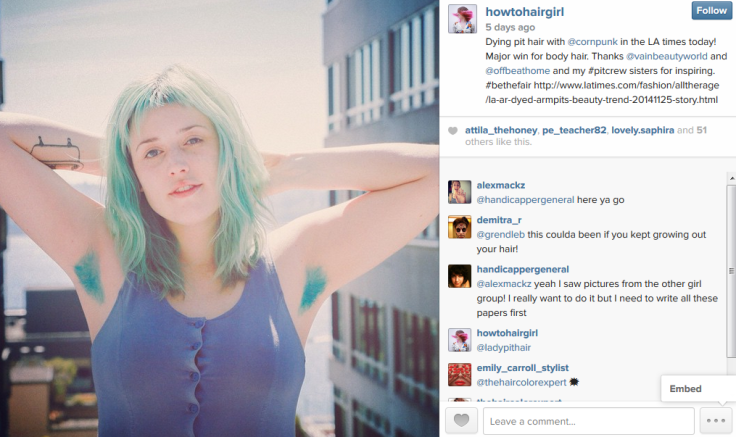Want To Dye Your Armpit Hair? What You Need To Know First

Women across the country are raising their arms high, and reaching for a box of hair dye, in a new and bizarre beauty trend: dyed armpit hair. Roxie Hunt, a Seattle stylist at Vain, unofficially spearheaded the movement after curiosity led her to experiment by dyeing her coworker Rain’s armpits a bright and vibrant blue to match her hair color. She's written about her experience on a blog post, which has garnered over 30,000 shares, and even inspired the Instagram hashtag #dyedpits — that, however, has less than 30 posts. Nevertheless, this is a movement people are definitely noticing.

“It's no secret that some of us choose not to shave or wax our pits. More and more often, I am meeting women who unapologetically choose not to succumb to the societal pressure of scraping a razor against the soft skin of their bodies. If you recall, I want to celebrate pit hair,” Hunt wrote on her blog.
The Seattle stylist went on to describe the process. “I began by mixing bleach and 30 volume developer. I knew I needed something strong enough to cut through that coarse hair and lighten it up as much as possible, but I didn't want to use 40 volume because I didn't want to cause any uncomfortable burning on the delicate skin in her pits.” After Rain wiped her pits down to remove any deodorant, Hunt got right in there with her bleach and color brush, “applying it thick in small sweeping strokes in all directions, making sure to fully cover every hair.”
Other women, like Hunt and Rain, have begun to embrace this new trend including Destiny M, a YouTube user, who made a video explaining her decision to dye her armpit hair bright blue after spending years of trying to hide her body hair. “[Growing out your hair] is so empowering. As a young girl, you are always told, hairless is beauty, it's perfection. But when you go against the grain like that... it's so empowering. I really recommend you try it,” she said in the video.
Not shaving one’s armpit air has been considered revolting, and warrants feelings of disgust not just from the media but from other women. A 2013 study published in the journal Psychology of Women Quarterly found women considered shaving a minor inconvenience and a personal choice, but the idea of body hair was revolting. Moreover, when female college students were asked to grow their armpit and leg hair for ten weeks and keep a journal about it, the participants wrote boyfriends and mothers were not supportive. The women felt or were told they were gross, disgusting, unclean, sloppy, and “ew.”
I did an experiment to see how it would look if I grew in my armpit hair and dyed it to match my head pic.twitter.com/XuYyAsBCSQ
— 'Cardigans' Kitty (@KittyKnits) November 2, 2014In April, London-based photographer Ben Hopper sought to protest sexist norms by recruiting dozens of models, actresses, designers, and friends to grow out their body hair as part of his Natural Beauty Series. “The whole point is contrast between fashionable female beauty and the raw unconventional look of female armpit hair,” Hopper said. The standards of beauty are so ingrained in people’s consciousness that seeing women’s body hair yields a “grossed-out” response.
Dyeing armpit hair makes a bright and bold statement against the preconceived notions and comes with several benefits. Growing your armpit hair keeps sweat away from the skin and helps to prevent over-heating of the lymph nodes under the armpits. It also acts as a human fragrance diffuser that allows one’s personal scent to intoxicate their environment. A 2007 study published in the Journal of the Royal Society of Medicine found the development of hair in regions such as the armpits is thought to facilitate the release of sex pheromones in sexually mature humans. This helps announce one’s presence and fertility to potential mates.
While the argument for not shaving is tied to smell being crucial to mating, dyeing your armpits does come with a risk. A 2001 study published in the International Journal of Cancer found women who regularly use permanent hair dye may be putting themselves at an increased risk for bladder cancer. Women who used permanent hair dye at least once a month were twice as likely to develop bladder cancer compared to women who did not use permanent hair dye. The amount of dye used is also an important factor when it comes to risk, as dark-colored hair needs more coloring than blonde.



























